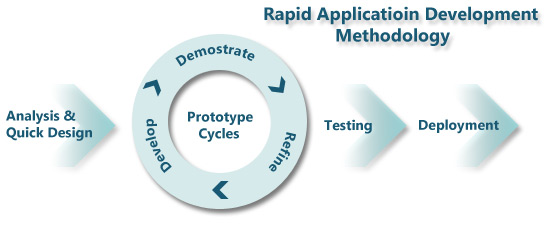Resource:Rapid Prototyping
Rapid Prototyping
Rapid Prototyping is a methodology commonly employed in many fields. Ultimately, the idea applys to instructional design. It is a cycle and a process, where a product or project is improved as time goes on. Ideas are tested and revised-- rapid prototyping shows this iterative formation of ideas and how projects are able to come to fruition.
On this wikipedia page, StartingBloc emphasizes the importance of this idea in social and community based ventures. It is taught and implemented in their conferences, where participants are taught what the methodology is, and are expected to apply it to their projects and organizations.
Rapid Prototyping in Action: A Visual
The best way to learn about rapid prototyping is to see a visual of the process. Below is a diagram that reflects how the method works.
Courtesy of Ramsoft Consulting, this diagram reflects the everchanging nature of designing a product.
The beginning of the model can be connected to the end, as it repeats in a cyclical nature.
The process begins with analysis and quick design. This can observe and test an existing idea, often ending in a desire to change a current system. After the system is observed, initial changes are made.
After this process is completed, prototype cycles work to test and implement changes. The cycles consist of development, demonstration, and refinery. These allow solutions to be created, implemented, and revised. These cycles are replicated at each step of the way. If the cycle proves to be successful, through the initial processes of analysis and design, it is deployed until further change is needed or desired.
Further Resources
A large portion of this page was written with information of the study, Rapid Prototyping Methodology in Action: A Developmental Study. It shows how the methodology was employed in various processes; while the context focused on consumer behaviors and product design, it is a broad framework that can be applied to many different fields.
Not surprisignly, rapid prototyping has many faces and different types of models. These can be utilized in different fields and may vary from the waterfall model to the spiral model. Read more about different methodolgies and how rapid prototyping is used here.
This TEDxKyoto video outlays the important components and dynamic nature of rapid prototyping in entreprenurship.
